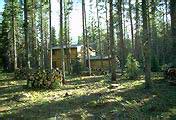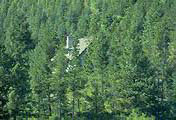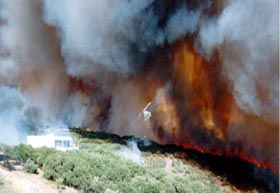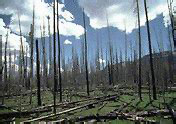Fort Collins Field Office – Wildfire Mitigation & Education
- Wildfire Hazard Evaluation and Mitigation
- Post-Fire Rehabilitation
- Wildfire Training
- Fort Collins Wildfire Links
Wildfire Hazard Evaluation and Mitigation


Fire is a natural process that provides ecological benefits. Hazards to life and property exist when a fire occurs and where conditions are conducive for the fire to grow. Efforts to suppress fires are intended to reduce these threats to life and property. The effect of fire on your property is partially determined by what you have done to effect fire’s behavior and by what your neighbors have done.
Although we all like to think the fire will be somewhere other than on our own property, fire is a part of forest ecology. It’s not a matter of if it happens, but when it happens.
Actions that forest landowners can take to make their forest resilient to fire and to keep their homes safe can be viewed in two categories: Defensible Space and Managing Your Forest.
Defensible Space is making your home more defendable and providing a safer working environment for firefighters. In Larimer County, defensible space design and marking services are provided by the Larimer County Wildfire Safety Program.
Many rural Colorado homeowners seek secluded, sheltered homesites. Many do not realize services such as fire protection, often taken for granted in the city, are not readily available at their mountain retreat. The photo above left shows a typical “secluded” mountain hideaway. The photo on the right (above) illustrates a “defensible space” created by the homeowner. Creating a defensible space around your home involves thinning vegetation adjacent to the structure and allows firefighters the opportunity to protect your home.
Note the intensity of the approaching flame front in relation to the helicopter located in the center of the photo
(right) and the continuous vegetation leading to the building.
Ground-based firefighters had no opportunity to defend this structure.
Working alone, you can significantly increase the chances of your home surviving a wildfire. If you work together with your neighbors and community, you can significantly increase the chances of returning to green trees in the event of a fire in your area.
Resources
- Home Ignition Zone Guide (2.7 MB PDF)
- Community Wildfire Protection Planning
- FireWise
- Ready, Set, Go!
Managing Your Forest – Once you have established a defensible space around your home, it is time to start managing the trees and vegetation around your home to reduce the fuel available to a fire. The Fort Collins Field Office is available to help you begin developing a forest management plan for your property.
For more information about managing your forest, please visit our Forest Management page.
Post-Fire Rehabilitation

CSFS assists affected landowners with wildfire rehabilitation plans following wildfire events. These plans outline structural erosion control measures and suggest needed re-vegetation to assist the land healing process. Many rehabilitation plans are implemented with cost-share assistance.
For more information about post-fire rehabilitation, please visit our Post-Fire Rehabilitation page.
Wildfire Training
Colorado Wildland Fire & Incident Academy – The academy has become the place for Colorado (now national and international) wildfire agencies to receive nationally-qualifying (NWCG) wildfire training.

